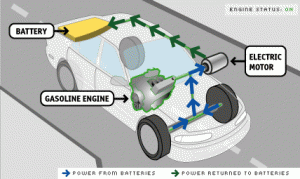In our busy modern lives, vehicles have become a major mean of transportation. It is also one of the major contributors of greenhouse gas. In recent years, many electrical cars and hybrid cars have been introduced to the general public, to make cars more environmentally friendly and also more energy efficient. While electricity is a much cleaner source of energy than fossil fuel, hybrid and electrical cars incorporated a new system for braking to save some of the energy that would be wasted in conventional vehicles.
When driving in the city, lots of energy is lost to heat when stopping the car and more energy is required to start the car again. This is why the fuel consumption for city is so much higher than highway for fossil fuel based cars. In hybrid and electrical cars, regenerative braking system can restore part of this energy back into electricity and store it in the battery for later use. Hybrid and electrical cars have a motor that can work as a generator. When the brake pedal is pushed, the wheels turn the motor and the motor generates electricity which is stored in the battery. Regenerative braking system is used together with conventional braking system as it slows down the car slowly and to prevent its failure (Woodford, 2009). According to Tesla, the efficiency of its regenerative braking system is about 64% (Solberg, 2007). The diagram and video below shows how a regenerative braking system works.
It seems that regenerative braking system is a specialty for hybrid and electrical cars however; there are other types of regenerative braking systems which can be used in conventional cars too. These systems include the flywheel, which stores energy in the flywheel when you want to brake and this energy is used later to start up the car (Woodford, 2009). A flywheel is a heavy wheel which stores energy by transfering it to rotation. There are also other regenerative braking systems which store energy by compression gas or hydraulic systems (Woodford, 2009). A compression gas or hydraulic system stores energy by compressiong gas when braking. While these systems can be used on conventional cars to increase their efficiency, but they are still not as efficient as electric motors and less applicable.
-Lincoln Li
Refrences
Volkswagen Electric Mobility: Animation Regenerative Braking

